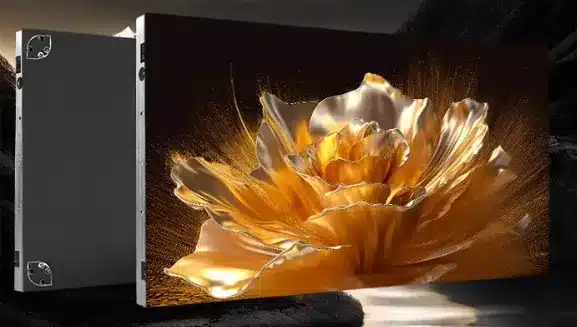A Brief Explanation of SMD and COB Packaging Technologies
1. Evolution of LED Display Technology
The development of LED display technology has gone through three major stages: DIP (Direct Insertion), SMD (Surface-Mounted Device), and COB (Chip On Board). Each transition represents a technological revolution leading to smaller pixel pitch and higher resolution.
In the future, Mini LED and Micro LED will continue this trend towards ultra-high resolution. However, due to technical challenges such as “mass transfer technology”, Mini and Micro LED displays are currently only applicable to small-sized devices like smartwatches and smartphones, and they are not yet viable for large-scale LED video walls.
COB technology has demonstrated its superiority over SMD and has received funding from China’s “13th Five-Year Plan” for strategic research in advanced electronic materials and new display technologies. The national strategic deployment highlights COB’s leading role in fine-pitch LED displays.
2. Comparison Between COB and SMD Technologies
Currently, the two dominant LED fine-pitch display technologies are:
- SMD (Surface-Mounted Device) Technology
- COB (Chip On Board) Technology
SMD Technology Overview
SMD involves a process where LED chips are first mounted on a bracket, connected via gold wire bonding, and encapsulated with epoxy resin. These SMD components are then soldered onto a PCB board using SMT (Surface Mount Technology) and high-temperature reflow soldering.
Limitations of SMD Technology
Reliability & Stability Issues
- LCD panels typically have a pixel failure rate of 1.5 PPM (parts per million).
- In contrast, SMD fine-pitch LEDs have a much higher factory failure rate of 50-100 PPM.
- Even after aging tests and pre-shipment repairs, failure rates increase within months of usage, requiring extensive after-sales service and spare parts.
Fragile Protection Capabilities
- SMD components, particularly 1010 and 0808 package sizes, have small soldering pads that are prone to weak solder joints.
- Exposed metal pins make them vulnerable to moisture, dust, and electrostatic damage.
- They are easily damaged during transportation, installation, and maintenance.
Pixel Pitch Limitation
- The mainstream pixel pitch for SMD LED displays is between P1.2 and P2.0, with very few products achieving sub-P1.0 resolutions.
3. How COB Solves SMD’s Limitations
COB (Chip On Board) technology is a next-generation fine-pitch LED display solution that eliminates the need for high-temperature reflow soldering.
How COB Works
- LED chips are directly attached to the PCB board using ultrasonic bonding.
- The entire PCB is encapsulated with epoxy resin, ensuring better durability and optical performance.
Advantages of COB Technology
1. Superior Reliability & Stability
- Eliminates the LED bracket and high-temperature soldering process, reducing failure rates significantly.
- Lower thermal resistance compared to SMD, enhancing heat dissipation and improving lifespan.
- COB displays experience 90% fewer failures than traditional SMD LED displays.
2. Stronger Physical Protection
- COB LED chips are embedded directly within a protective resin layer, making them resistant to moisture, dust, static, and physical damage.
- This provides outstanding durability for transportation, installation, and long-term use.
3. Better Optical Performance
- Traditional SMD displays suffer from glare, ghosting, and Moiré patterns due to individual LED sources.
- COB displays, being an integrated light source, deliver better uniformity, wider viewing angles, and reduced light diffraction, resulting in smoother images.
4. COB’s Rapid Market Adoption
With its clear advantages, COB technology is gaining widespread industry adoption. Leading companies such as Leyard, Unilumin, Absen, Nationstar, and Osram are actively launching COB-based LED displays.
Final Thoughts
COB technology bridges LED packaging and display innovation, making it the future of fine-pitch LED displays. As the industry continues to evolve, COB will play a crucial role in high-resolution LED applications.
